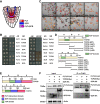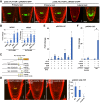Root stem cell niche organizer specification by molecular convergence of PLETHORA and SCARECROW transcription factor modules
- PMID: 30018102
- PMCID: PMC6075145
- DOI: 10.1101/gad.314096.118
Root stem cell niche organizer specification by molecular convergence of PLETHORA and SCARECROW transcription factor modules
Abstract
Continuous formation of somatic tissues in plants requires functional stem cell niches where undifferentiated cells are maintained. In Arabidopsis thaliana, PLETHORA (PLT) and SCARECROW (SCR) genes are outputs of apical-basal and radial patterning systems, and both are required for root stem cell specification and maintenance. The WUSCHEL-RELATED HOMEOBOX 5 (WOX5) gene is specifically expressed in and required for functions of a small group of root stem cell organizer cells, also called the quiescent center (QC). PLT and SCR are required for QC function, and their expression overlaps in the QC; however, how they specify the organizer has remained unknown. We show that PLT and SCR genetically and physically interact with plant-specific teosinte-branched cycloidea PCNA (TCP) transcription factors to specify the stem cell niche during embryogenesis and maintain organizer cells post-embryonically. PLT-TCP-SCR complexes converge on PLT-binding sites in the WOX5 promoter to induce expression.
Keywords: Arabidopsis; PLT-TCP-SCR complexes; WUSCHEL-RELATED HOMEOBOX 5; organizer; quiescent center; stem cell niche.
© 2018 Shimotohno et al.; Published by Cold Spring Harbor Laboratory Press.
Figures






References
-
- Aida M, Beis D, Heidstra R, Willemsen V, Blilou I, Galinha C, Nussaume L, Noh YS, Amasino R, Scheres B. 2004. The PLETHORA genes mediate patterning of the Arabidopsis root stem cell niche. Cell 119: 109–120. - PubMed
-
- Benfey PN, Linstead PJ, Roberts K, Schiefelbein JW, Hauser MT, Aeschbacher RA. 1993. Root development in Arabidopsis: four mutants with dramatically altered root morphogenesis. Development 119: 57–70. - PubMed
-
- Bennett T, Scheres B. 2010. Root development-two meristems for the price of one? Curr Top Dev Biol 91: 67–102. - PubMed
Publication types
MeSH terms
Substances
LinkOut - more resources
Full Text Sources
Other Literature Sources
Molecular Biology Databases
Research Materials
Miscellaneous
